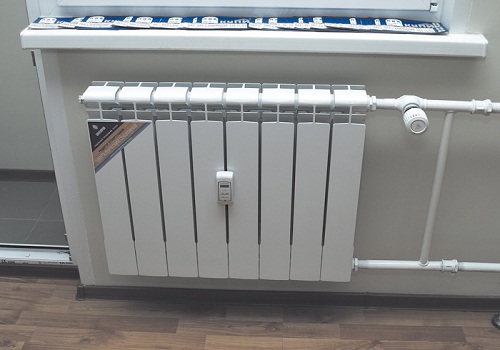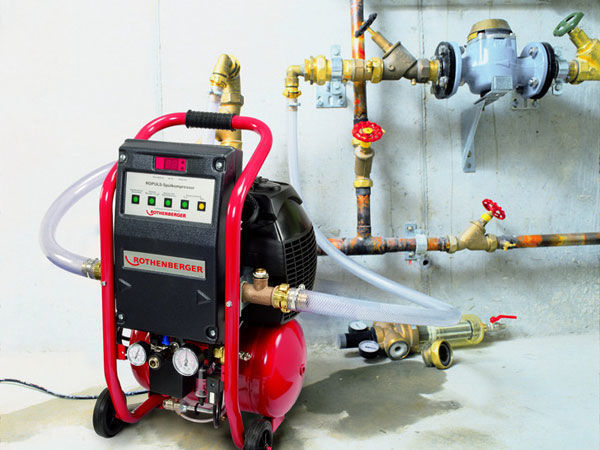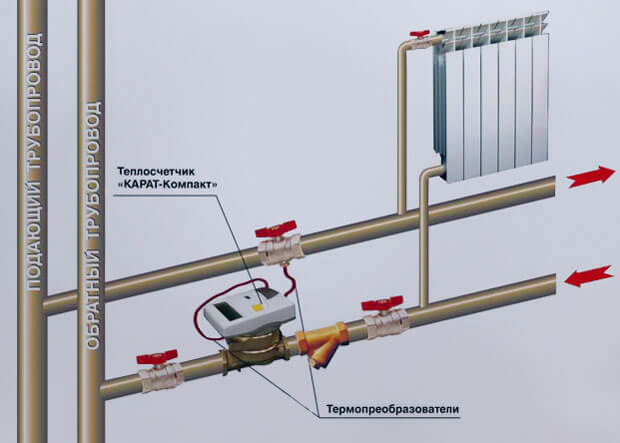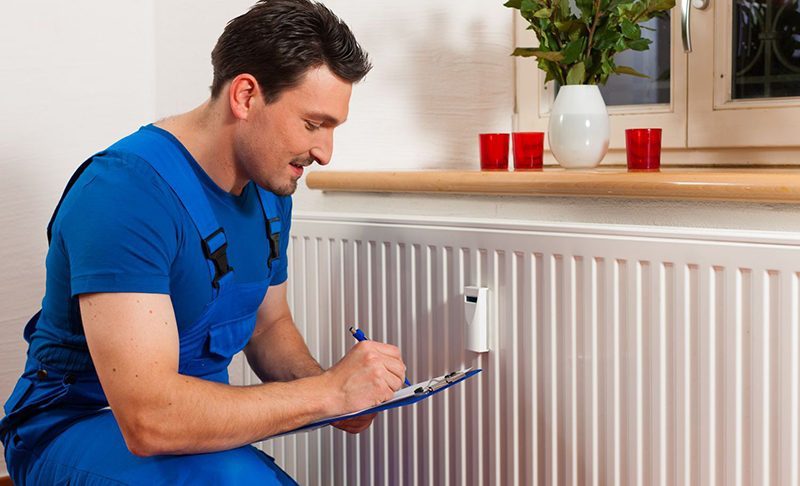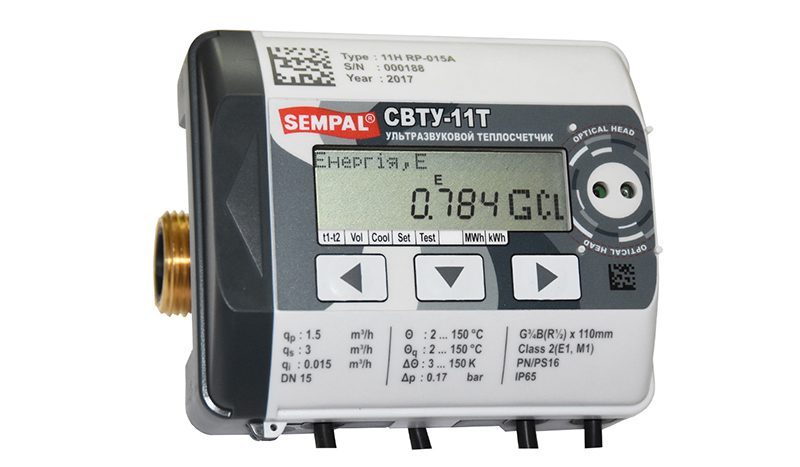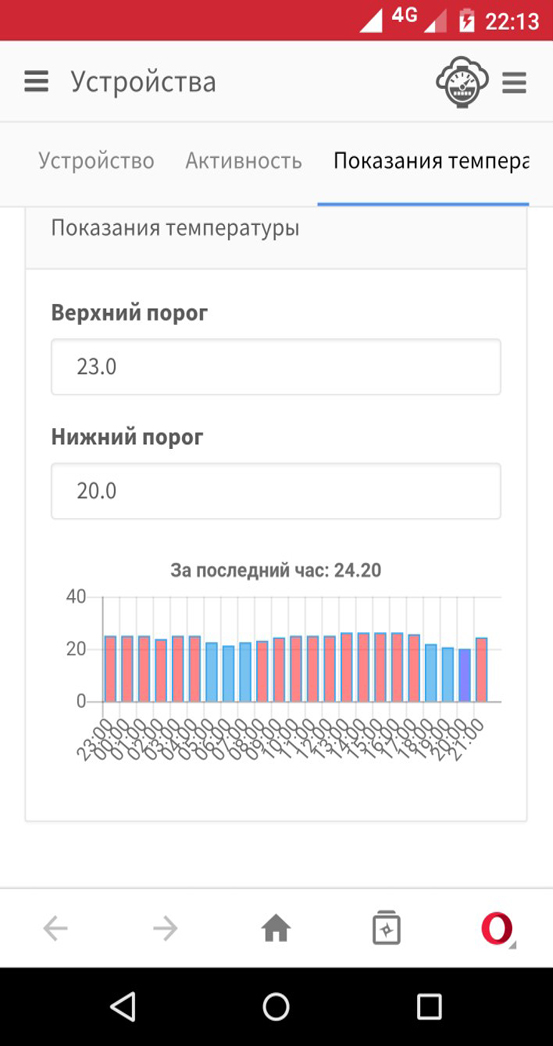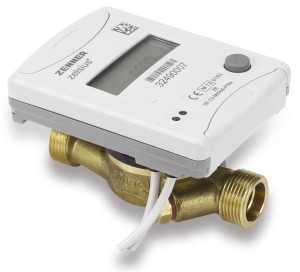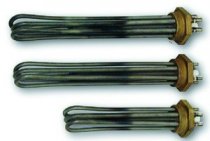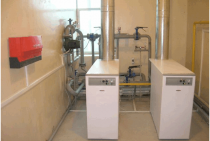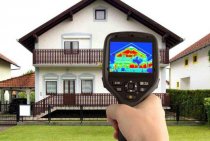What to Consider When Deciding to Install a Meter
Depending on your heating system wiring diagram, some difficulties may arise. So with a horizontal wiring diagram, it will be enough for you to put one meter at the entrance of the heating pipes to the apartment, but what if you have a vertical wiring diagram. I have a vertical layout in my apartment and 4 risers of heating pipes, and it turns out that when installing a heat meter, I will have to install a meter for each heater. Naturally, this option is not profitable, but not everything is so bad. Manufacturers of heat meters produce distributors that measure the flow rate of the coolant based on the difference between the surface temperature of the heating device and the temperature of the indoor air. The cost of this equipment together with the installation will be approximately from 3 to 7 thousand rubles, it all depends on the configuration of the equipment.
When to flush the heating system
The frequency of flushing is always regulated by individual technical standards, but you can also talk about emergency situations, which include:
- Increasing the hydraulic resistance of the heating system to critical values. It is possible to diagnose this danger only on special equipment.
- Inefficient operation of the system. This is expressed in an increase in heating costs, uneven heating of appliances, as well as significant fuel consumption. With the formation of deposits inside the batteries and pipes, their efficiency drops significantly.
- Replacement of a single section of pipes or several batteries.
- Preventive flushing of the heating system at home. Ideally, it should be carried out after the end or at the beginning of the heating season, once every 3 years.
Installation of an individual heat meter
Step one
. It is necessary to eliminate the existing sources of heat loss, including cracks in the windows, insufficiently insulated entrance doors, and freezing corners. Only after this, the installation of a heat meter will result in significant savings in money.
step two
. The management company (ZHEK, HOA) must provide the owner of the apartment with technical conditions (TU) - they attribute the requirements that must be met in order to connect. Usually the text of the conditions takes up an A4 sheet. It certainly indicates information about the temperature and pressure of the coolant entering the pipeline of a particular house.
Step Three
. Knowing these parameters, you can start buying a heat meter without fail in a company that works legally. When purchasing the device, you must require a sales receipt and cash receipt, a certificate confirming the quality, rules and instructions for use.
Step Four
Step Five
. A measuring thermal device is being installed by employees of a licensed organization specializing in this type of service.
When choosing a company, it is advisable to pay attention to a number of nuances:
- for the availability of information about the organization in the Unified State Register of Legal Entities;
- for the presence of a package of necessary documentation, including certificates, certificates, permits of SROs;
- availability of qualified specialists;
- availability of special equipment;
- to perform a full list of installation works;
- availability of a free visit of a specialist to the client’s apartment in order to inspect communications;
- availability of warranties for the work performed.
Step Six
Types of devices
If you plan to install equipment in an apartment, then before starting the search for a suitable company that will carry out the installation, you will need to make sure that the house has horizontal heating distribution, when a separate pipe leaves the central riser for each floor.
With one of the two types of vertical wiring, it is irrational to install an apartment meter, because there are several risers in the house, and a separate device will need to be installed on each of them, in which case common house equipment is installed that records the readings of the heat meter of the entire building, and payment is made in accordance with the heated square meters of housing.
You can proceed to the choice of the type of device. The ideal does not exist and you will need to compare the pros and cons of each of them in order to determine the option that is acceptable to you from four possible options:
- Mechanical.
- Ultrasonic.
- Vortex.
- Electromagnetic.
Taking readings from a heat meter of any of these types has no fundamental differences and can differ only in terms of designations and the number of recorded values.
What information does the meter provide?
A heat energy meter is a complex mechanism that captures signals from heat carrier volumetric flow and temperature sensors. The computing unit of the heat meter makes the appropriate calculations and provides results for the following parameters:
- the amount of heat energy used for a certain period (in gigacalories);
- amount of cooling energy (in gigacalories);
- thermal power (thermal energy consumption per hour);
- volumetric flow rate of the heat carrier (both in the supply pipe and in the return pipe. Measured in cubic meters per hour);
- volume of heat carrier in each pipeline (in cubic meters);
- coolant temperature in the supply pipeline (in degrees Celsius);
- temperature of the heat carrier in the return (in degrees Celsius);
- temperature difference (in degrees Celsius);
- date Time.
Positive and negative sides of meters
Consider how to take readings from a heating meter in an apartment using the example of a mechanical type from SensoStar, Gross and Supercal. Such an apparatus is equipped with an impeller, which rotates during the passage of the coolant flow. The part is connected to a sensor that reads the revolutions and determines the volume of liquid. To set the current consumption, the device is equipped with a liquid crystal monitor, which shows the amount of thermal energy in Gcal, the accounted volume of flowing hot water, the temperature of the carrier on the inlet and return pipes.
Ultrasonic equipment measures the speed and wavelength that passes through the movement of the coolant flow and back. Calculation takes place according to the received data. This type of device is ideal for accounting for the consumption of thermal energy in closed and open water supply systems. It is advisable to take readings of the heat energy meter from equipment from the German Sharky or Ukrainian Sempal.
Vortex devices analyze the turbulences that form when a coolant flow passes through an obstacle. It is not difficult to take readings from a heat meter of this type, but you will need the help of a qualified specialist who understands all the capabilities of the equipment and knows how to manage it. Recommended products for installation are Ultraheat, Karat and TSK.
Electromagnetic-based heating meter readings are more accurate because the analyzer makes calculations based on measurements of the current that is generated when hot water passes through a magnetic field. Data is taken directly, through a monitor with a control system, by connecting external drives, where archived data is copied, or through a remote connection. Among the manufacturers, users note the companies DIO, Amis and Pramer.
Types of heat meters
All heating meters available for purchase are divided into the following types:
Tachometric or mechanical
It measures the amount of coolant that has passed through the section of the pipe using a rotating part. The active part of the device can be screw, turbine or in the form of an impeller.The devices are affordable and easy to use.
The weak side of such devices is sensitivity to dirt and sedimentation inside the mechanism of dirt, rust, and water hammer. For this, a special magnetic mesh filter is provided in the design. Also, the devices are not able to store the data collected per day.
Ultrasonic
It is most often used as a general meter in an apartment building. It has varieties:
- frequency,
- temporal,
- doppler,
- correlation.
It works on the principle of generating ultrasound passing through water.
The signal is generated by the transmitter and picked up by the receiver after passing through the water column. Guarantees high measurement accuracy only with sufficient purity of the coolant.
Electromagnetic
Differs in high accuracy of indications and cost. The operation of the device is based on the principle of passing a magnetic field through the coolant flow, which reacts to its state. The device needs periodic maintenance and cleaning. It consists of a primary converter, an electronic unit and temperature sensors.
Vortex
It works on the principle of measuring the number and speed of vortices. It is not sensitive to clogging, but reacts to the appearance of air in the system. The device is installed in a horizontal position between two pipes.
Is it possible to be present when taking readings of heat meters
It is possible and even necessary. It is necessary to be present when taking readings from heat meters, first of all, for the peace of mind of the residents of the house, for the correct reading of readings, this is not necessary.
What necessary to take readings from the heat meter.
Get a notebook or a small notebook, put it in a shield or box with a heat meter installed, and record the heat meter readings at the same time as the readings are taken by the service organization.
Apartment heat energy meter how to properly remove and transmit readings
Readings from apartment heat meters should be taken by analogy with water meters. The only difference is that heat meters display several indicators on the indicator, and in order to choose the right one, you should carefully read the operating instructions and strictly follow the manufacturer's recommendations. After receiving the necessary information, the difference in the readings for the previous and reporting periods should be entered into the receipt for payment for thermal energy, multiplied by the tariff established in the region, and the amount received should be paid.
Currently, modern heat meters are equipped with a built-in interface that allows you to read data automatically. For example, the domestic-made Kombik-T counter has a built-in radio antenna, which allows you to take readings from the device even without entering the apartment. It should be noted that a water meter (water meter) with a pulse output can be connected to such a device, which will allow you to take readings of water consumption (hot and cold) also without visual contact
The installation of such metering devices will be a good solution for people who often go on business trips or trips and cannot personally meet the controller who comes to take readings.
Please note that an individual heat meter can only be installed in apartments with horizontal piping and separate heat carrier inlets. In houses where heating systems with vertical wiring are equipped, individual meters are not installed
From the information provided in this article, we can conclude that the procedure for taking and transmitting readings from heat meters should be treated with a sufficient measure of responsibility.
Currently, in almost all Russian regions, charges for utilities occur according to the same scenario: the tenant sends readings from his metering devices to the management company,and the Criminal Code takes readings from common house meters and calculates the difference in readings between them and individual meters.
If this difference is not more than the standards for common areas (stairwells, corridors, basements, etc.), it is proportionally divided among all residents. Otherwise, the management company pays the difference from its income. If the tenant did not submit readings from his metering devices to the Criminal Code in a timely manner, or his devices ended the calibration interval, then for the first two months the management company charges for the consumed resources, taking into account the average consumption for the previous period. In the future, the Criminal Code calculates payment based on the standards for a particular region.
As a rule, the standards significantly exceed the real need for resources. For example, in central Russia in modern energy-efficient houses, real heat consumption in 2-2.5 times less than the standard
. Accordingly, the timely transfer of testimony, first of all, is in the interests of the tenant himself.
The process of taking readings from a heat meter is described in. In this article, we will talk a little more about how to read the SANEXT heating meter.
Apartment heat energy meter how to properly remove and transmit readings
Readings from apartment heat meters should be taken by analogy with water meters. The only difference is that heat meters display several indicators on the indicator, and in order to choose the right one, you should carefully read the operating instructions and strictly follow the manufacturer's recommendations. After receiving the necessary information, the difference in the readings for the previous and reporting periods should be entered into the receipt for payment for thermal energy, multiplied by the tariff established in the region, and the amount received should be paid.
Currently, modern heat meters are equipped with a built-in interface that allows you to read data automatically. For example, the domestic-made Kombik-T counter has a built-in radio antenna, which allows you to take readings from the device even without entering the apartment. It should be noted that a water meter (water meter) with a pulse output can be connected to such a device, which will allow you to take readings of water consumption (hot and cold) also without visual contact. The installation of such metering devices will be a good solution for people who often go on business trips or trips and cannot personally meet the controller who comes to take readings.
From the information provided in this article, we can conclude that the procedure for taking and transmitting readings from heat meters should be treated with a sufficient measure of responsibility.
Today I will tell you how to convert Gcal to kWh and vice versa. The length, width, thickness of an object can be measured with a tape measure. The weight of an object can be determined by weighing it. But the amount of thermal energy cannot be measured either with a tape measure, or with the help of scales or some other simple measuring instruments. Thermal energy can only be calculated mathematically. Like any quantity, thermal energy has its own units of measurement.
Meters, centimeters, millimeters, decimeters, kilometers, nanometers, etc. are units of length. As you may have guessed, kilograms, grams, tons, etc. are units of weight.
But Gcal, kWh, J are units of heat energy. Moreover, just as meters can be turned into millimeters, and kilograms into grams, Gigacalories can be easily converted into kWh and J. When you install your heat meter, you will have to learn how to convert Gcal to kWh and back.
You need to be able to do this in order to transfer the readings of this meter to your UK (management company). The fact is that some meters give readings only in Gcal, and some only in kWh.Management companies accept meter readings in only one unit. So you have to recalculate every month. Recalculation is no trick.
Let's say you want to convert 1 Gcal (one gigacallorie) into kWh, then you need to remember that one kWh is equal to 0.000860 Gcal. We compose the simplest proportion:
1 kWh = 0.000860 Gcal
We recall mathematics at school, and calculate what X equals to W * h in this proportion: X \u003d 1 kW * h x 1 Gcal / 0.000860 Gcal \u003d 1162.8 kW * h
Or vice versa, you need to convert 1 kWh (one kilowatt hour) to Gcal. Again we make a proportion, remembering that one kWh is equal to 0.000860 Gcal.
1 kWh = 0.000860 Gcal
Again, we do calculations based on the usual proportion: Х= 1kW*h x 0.000860 Gcal/ 1kW*h= 0.000860 Gcal
Here, in fact, we figured out the transfer of Gcal to kWh. Everything is easy and very simple. Especially when you make these simple calculations every month, after taking readings from the heat meter. But we will explain how to remove them in the next chapter.
By the way, I deliberately did not give any coefficients for converting Gcal to J and kWh to J. Simply because usually such a unit as J (joules) is practically not used now. It's like decimeters in the measurement of length. Decimeters seem to be there, you can and should know about them, and nothing more. The same epic with Joules.
Another subtlety that you need to know about is the Kilo, Mega and Giga prefixes.
For example, kWh (kilowatt per hour), or MWh (megawatt per hour). Kilo is 1000, Mega is 1000000 and Giga is 1000000000.
1 kWh = 1000 Wh.
1 MWh = 1000000 Wh = 1000 kWh.
1 Gcal = 1000000000 Cal = 1000 Mcal = 1000000 kcal.
If you need more temperature, humidity, voltage, current and more
Starting with accounting for resources, we went further - we organized the ability to monitor temperature and humidity, voltage and current values through the KUB-Infra service, as well as remotely control something at the facilities, for example, de-energize all sockets with one click.
It is especially pleasant that all these functions can be organized using the same KUB-Infra controller. The device provides all relevant inputs/outputs for sensors. Therefore, if you need to organize something else in addition to accounting for resources, it is enough to purchase the appropriate sensor (temperature, humidity, current sensor, voltage control unit, etc.), and connect it to KUB-Infra. You will track the parameters in the same place - in your personal account on the KUB-Infra service. At the same time, if the parameter goes beyond the norm, the system will notify you by e-mail or via messenger.
When using apartment heat meters, you can significantly reduce heating costs. All this happens not only due to more accurate accounting of consumed heat, but also due to the fact that the consumer is interested in more economical use of thermal energy. He begins to regulate the flow of coolant through his heating device in the apartment, as well as insulate walls, windows, etc.
Sometimes the benefit is obvious and the heat meter pays off in a matter of months, but the opposite often happens when the amount of energy consumed by the meter is more than the normative indicators. We will talk about how to choose the right counter and the need to install it in this article.
What you should pay attention to and whether it is worth installing a counter.
What to Consider When Deciding to Install a Meter
Registering a heat meter
How to take readings correctly?
You decide to install a meter, what should you be guided by when choosing an installation organization
Reading methods
If you have a device with visual reading installed, you can only take readings directly from the information board. The consumer can record the data himself, and then transfer it to the management company or service provider organization. In addition, employees of the management company or heat supply service can take readings. The consumer is obliged to provide them with access to the heat meter located in the apartment.
Remote reading of data is also possible. To do this, the device must be equipped with one of the following modules:
- impulse output.It is equipped with a sealed contact, the closure of which leads to the formation of an electrical impulse. This impulse is recorded by a reader, which transmits information to an automated control room;
- radio output - information is transmitted over a radio channel independent of cellular communications;
- digital output. The RS-485 interface is used. Data is transmitted over a wired communication line.
Remote reading is relevant if access to the heat meter is difficult or a common house metering system is organized in an apartment building. Equipping devices with these modules allows not only remotely reading information, but also storing it in a non-volatile archive for further viewing, output to paper, and inclusion in reporting documentation.
Restrictions on installing a heat meter in an apartment
In such a situation, there is only one solution - to put meters on radiators, but such a solution is difficult to implement for the following reasons:
- the installation of several heat appliances in one apartment will cost its owners a tidy sum, since each meter for a heating battery costs a lot of money;
- taking readings from each device is hampered by the fact that utility workers are not able to make monthly rounds of all the rooms in the apartments of the house in order to record data. When doing this work on your own, you can get confused in the numbers and make mistakes in the calculations;
- maintenance problems - several devices are much more difficult to control and verify their correct functioning;
- the meter for the heating radiator has poor accuracy, since the difference at its inlet and outlet is so small that the device is often unable to fix it.
A heat meter is a device for recording the consumed heat carrier, which is currently very profitable, as it allows you to save money by paying only for the consumed heat, eliminating overpayment.
An important point is the correct choice of the type of device depending on the installation location and design features of the heating network, as well as the conclusion of an agreement with a service organization that will monitor the technical condition of the device.
There are many models of heat meters that differ in design and size, but the principle of how the heating meter works remains the same as on the simplest device that measures the temperature and water flow at the inlet and outlet of the heat supply pipeline. Differences appear only in engineering approaches to solving this issue.
The operation of the heat meter is based on the principle of calculating the amount of heat using data taken from a coolant flow sensor and a pair of temperature sensors. There is a measurement of the amount of water that has passed through the heating system, as well as the temperature difference at the inlet and outlet.
The amount of heat is calculated by the product of the flow rate of water passing through the heating system and the temperature difference between the incoming and outgoing coolant, which is expressed by the formula
Q \u003d G * (t 1 -t 2)
, gcal/h, in which:
- G
is the mass flow rate of water, t/h; - T1,2
- temperature indicators of water at the inlet and outlet of the system, o C.
All data from the sensors are sent to the calculator, which, after processing them, determines the value of heat consumption and records the result in the archive. The value of the consumed heat is displayed on the display of the device and can be taken from any moment.
What affects the accuracy of the heat meter

Techem compact V
A heat meter, like any precision device, has a certain total error when measuring consumed heat, which is the sum of the errors of temperature sensors, a flow meter and a calculator. In apartment accounting, devices are used that have an allowable error of 6-10%.The actual error rate may exceed the base one, depending on the technical characteristics of the components.
The increase in the indicator is determined by the following factors:
- The amplitude of the incoming and outgoing coolant temperature, which less than 30 o C
. - Violations during installation in relation to the requirements of the manufacturer (when installed by an unlicensed organization, the manufacturer withdraws warranty obligations from it).
- Inadequate quality of pipes, hard water used in the coolant, and the presence of mechanical impurities in it.
- When the coolant flow rate is below the minimum value indicated in the technical characteristics of the device.
How is heat consumed measured?
It is customary to calculate the tariff for consumed heat in gigacalories. The unit of measurement refers to non-systemic, and has been traditionally used since the existence of the USSR. Appliances made in Europe calculate the consumed heat in GigaJoules (SI), or a generally accepted international non-systemic unit kWh (kWh)
.
Breakdowns and repairs

Instrument maintenance It is limited to maintaining it in working condition, regular inspection, and avoiding causes that cause premature wear and breakage. According to paragraph 80 of the Rules for the commercial accounting of the coolant, all maintenance and control of the correct operation of the meter is carried out by the consumer. On the part of the owner, he does not need special care.
The lithium battery or batteries that power the device are not suitable for reuse and should be disposed of if they fail.
If any malfunction in the operation of the metering device is detected, the consumer must notify the service company and the organization providing heat supply within 24 hours. Together with the arrived authorized employee, an act is drawn up, which is then transferred to the heat supply organization with a report on heat consumption for the corresponding period. In case of untimely notification of a breakdown, heat consumption is calculated in a standard way.
The service company will provide services for the repair or replacement of the meter, and may install a replacement device during the repair. The cost of installation and dismantling, repair and other services is regulated by an agreement between the consumer and the service company.
Error logging
As standard, heat meters are equipped with a self-testing system that can detect inaccuracies in operation. The calculator periodically queries the sensors, and if they fail, fixes an error, assigns a code to it and writes it to the archive. The most common reported errors are:
- Incorrect installation or damage to the temperature sensor or flow device.
- Insufficient battery charge.
- The presence of air in the flow path.
- No flow if there is a temperature difference for more than 1 hour.
Removal and installation of the heating meter
Before installing a heating meter in an apartment or apartment building, specialists from specialized companies that have permits for this type of work are invited. Based on the specific situation, they can take on the following obligations:
- Develop a project.
- Submit documents to certain authorities in order to obtain permits.
- Install and register the device. In the absence of registration, payment for the supplied heat is made according to the established tariffs.
- Carry out test tests and put the device into operation.
The developed project should include the following points:
- Type and device of the model, which is designed to work in a particular heating system.
- Necessary calculations for heat load and coolant flow.
- Scheme of the heating system with the installation location of the heat meter.
- Calculation of possible heat losses.
- Calculation of payment for the supply of thermal energy.
Checking heating meters
As a rule, a quality device arrives at the point of sale initially tested. The procedure is carried out at the factory, which is evidenced by a stamp with a record corresponding to the record in the documentation. In addition, the documents indicate the calibration interval.
After this period, the owner of the device must contact the service center of the manufacturer or an organization authorized to check and install the meter. There are companies that, after installing the device, are engaged in its maintenance.
Periodic confirmation of the metrological class, or in a word, verification, is carried out by a specialized company that has pouring installations, as well as a permit issued by the metrological supervision authorities.
The calibration period depends on the type of device, and averages 4-5 years.
For this purpose, a metrologist is called, seals are removed, a specialist from a service organization dismantles the meter and sends it for verification. After checking and reassembly, the device is sealed.
A heating meter is a device for accounting for thermal energy, which allows you to save money by paying only for the actually consumed service. Failure to comply with the conditions below will lead to the inability to pay for heat according to the meter readings.
For the correct and long-term operation of the device, it is important to choose the type of meter, which must be present in the state register of measuring instruments acceptable for use, and also have metrological certification in the appropriate authority. The device is installed by a company licensed to carry out such work.
The device is installed by an enterprise licensed to carry out such work.
